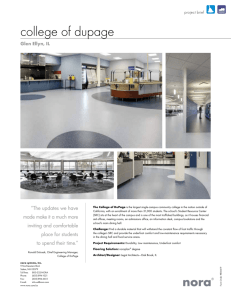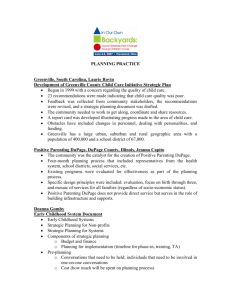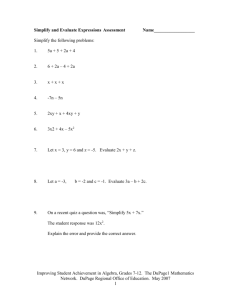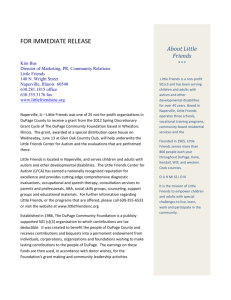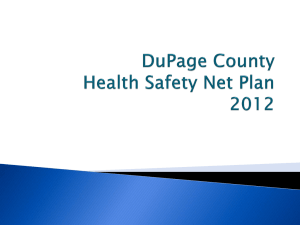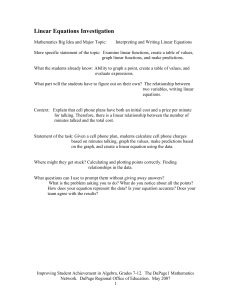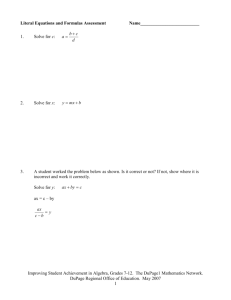Who is the Access DuPage Program For?
advertisement
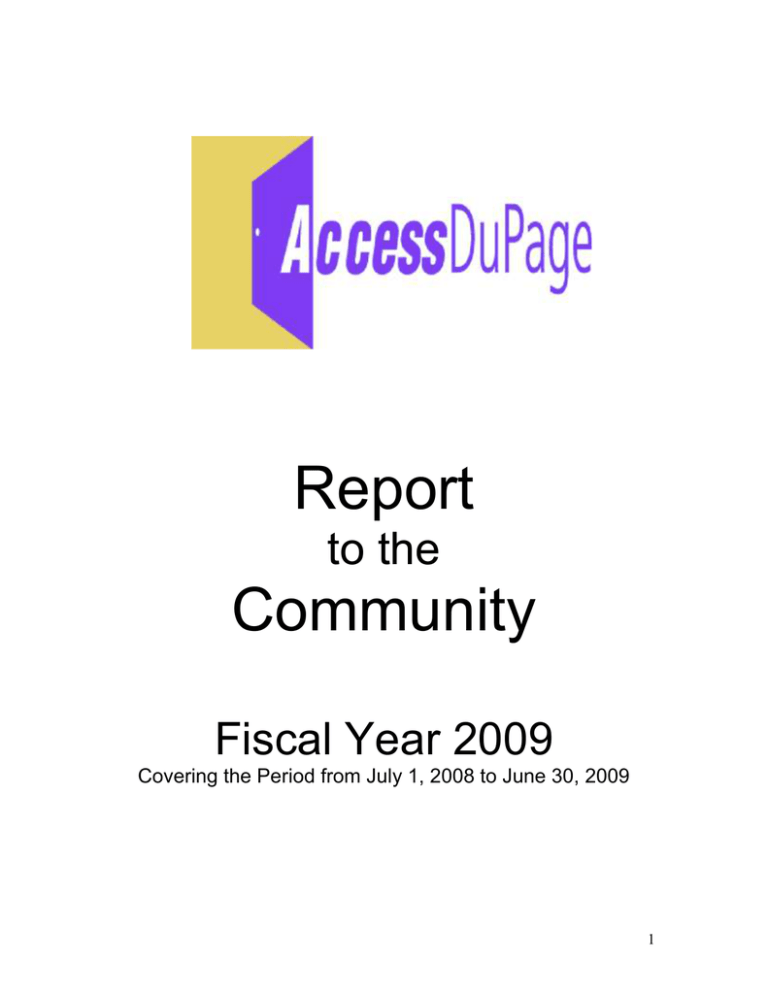
Report to the Community Fiscal Year 2009 Covering the Period from July 1, 2008 to June 30, 2009 1 What is Access DuPage? Access DuPage is a collaborative effort by hundreds of individuals and organizations in DuPage County to provide access to medical services to the county’s low-income, medically uninsured residents. Access DuPage represents a unique partnership of hospitals, physicians, local government, human services agencies, and community groups working together to address this formidable issue. Access DuPage was organized in 2001, and began enrolling persons into the Access DuPage program in February, 2002. Since Access DuPage in a very real sense was founded by and is sustained by the entire DuPage County community, it is only fitting that we give an accounting to the community of how the program is working. In this report we will focus specifically on Fiscal Year 2009, covering the period from July 1, 2008 to June 30, 2009. Who is the Access DuPage Program For? A person is eligible for Access DuPage if he/she: 1. has resided in DuPage County for at least 30 days; 2. is under age 65; 3. has a household income below 200% of the Federal Poverty Level; 4. has no medical insurance; and 5. is not eligible for public health insurance programs (e.g., Medicaid, Medicare). Qualified applicants are enrolled in the Access DuPage program for a period of one year, after which they must re-apply for membership in the program and their eligibility criteria must be re-verified. 2 How Does the Access DuPage Program Work? The Access DuPage program is based on three inter-locking strategies: 1. The Medical Home Strategy – Our first priority is to link every enrolled member with a primary care “medical home” – a clinic or a physician that provides ongoing routine medical care and coordinates more specialized care. This strategy recognizes (a) that having access to ongoing primary care is a pre-requisite for having access to other types of medical services; and (b) that programs addressing broader health goals (e.g. prevention, education, disease management) will be more effective if they are built on a solid primary care foundation. 2. The Continuum of Care Strategy – This strategy recognizes that physicians and other providers will be quickly hamstrung if their patients do not have ready access to all of the other typical medical services needed to manage the overall health of each patient. Thus emphasis has been placed on developing a coordinated network of resources across the entire continuum of medical care to which the patient can be referred, and on creating processes that provide convenience to the patient and maximize provider effectiveness and efficiency. 3. The Mosaic Strategy – In pursuing its mission Access DuPage incorporates multiple programs, models and organizations. The structure of the program allows each of these components to do what it does best, while emphasizing coordination, integration, non-duplication, and synergy in the design of how the various components interact with each other. A byproduct of this strategy is a much higher level of inter-agency and inter-sector communication and cooperation in DuPage County than existed previously. In accordance with these strategies, each person enrolled in Access DuPage is first assigned to a participating primary care physician or clinic as his/her ongoing source of primary care. This primary care provider may be: The DuPage Community Clinic, a “free clinic” which has served the poor since 1989 using volunteer physicians and other health professionals; One of several federally-qualified community health centers (FQHCs) in DuPage County, which are managed by Access Community Health Network, the largest network of community health centers in the nation; or One of several hundred primary care physicians who graciously accept Access DuPage members into their private practices. Other medical services are obtained in the following ways: Members receive laboratory or radiology services, when ordered by a participating physician, free of charge at a participating hospital. When specialty physician care is required, Access DuPage locates a specialist who agrees to see the patient without charge. 3 DuPage County hospitals provide inpatient care and other intensive services to Access DuPage patients without charge, and 21 hospital-based physician groups in DuPage County waive professional fees for Access DuPage patients. Most prescription drugs ordered by a participating physician are available to members in one of three ways: o Medications may be available without charge on site at the DuPage Community Clinic or at a physician’s office; o Medications may be obtained without charge through one of the Drug Assistance Programs sponsored by many pharmaceutical companies; or o If neither of the first two situations applies, most drugs may be purchased by Access DuPage members at dozens of pharmacies in DuPage County with a modest co-payment ($10 for a generic drug; $20 for brand name drug on the Access DuPage formulary; $50 for non-formulary drugs). Access DuPage does not provide non-medical services, but works closely with community agencies to coordinate referrals when they are required. 35 community organizations throughout DuPage County assist Access DuPage in verifying eligibility and assisting eligible persons through the enrollment process. As you can see, Access DuPage engages virtually the entire medical community of DuPage County in providing care to the neediest members of the community. It engages virtually the entire human services network to identify potential members and enroll them. In this way the Access DuPage program helps provide coordination and integration among many of the wonderful programs and services that exist in DuPage County. 4 FY09 Outcomes at a Glance Listed below are the seven major goals of the Access DuPage program, and the outcomes related to each of these goals that were achieved in FY09. Goal One: Maintain the capacity of the Access DuPage program to serve all eligible applicants to the program. 7,404 Persons enrolled in the program on July 1, 2008 9,406 Persons enrolled in the program at June 30, 2009 (27.0% increase) 8,455 Average monthly enrollment in FY09 13,039 Total number of persons enrolled at some point during FY09 72.1% Re-enrollment rate in FY09 0 Number of applicants on waiting list at the end of FY09 5 Goal Two: Serve vulnerable persons regardless of race, ethnicity, gender, language, religion, education, sexual orientation, or ability to pay. Persons enrolled in program as of June 30, 2009: Gender: Female Male 56.2% 43.8% Age: 18-25 26-35 36-45 46-55 56-65 66+ 12.2% 24.2% 22.6% 21.8% 18.7% 0.6% Household Income: < 100% Federal Poverty Level 100-200% FPL 58.4% 41.6% Ethnicity Hispanic White Asian/Middle Eastern African American Other 55.8% 23.6% 14.4% 4.0% 2.1% Primary Language Spanish English Other 53.9% 33.0% 13.1% Community of Residence: West Chicago Glendale Heights Addison Carol Stream Wheaton (incl. homeless) Naperville Villa Park Bensenville Lombard Glen Ellyn Hanover Park Woodridge Warrenville Westmont Aurora Lisle Downers Grove All Others 17.0% 9.7% 9.5% 7.2% 6.0% 5.0% 4.9% 4.8% 4.7% 3.8% 3.3% 3.0% 2.9% 2.5% 2.3% 2.2% 2.0% 9.0% 6 Goal Three: Ensure that Access DuPage Members receive the medical services they need. Goal Four: Ensure that Access DuPage members use the health system efficiently. Numbers and Utilization Rates of Major Types of Medical Services Received by Access DuPage Members During FY09 Actual Typical 1 Type of Services Total Received Rate/1,000 Rate/1,000 Office-based Primary Care Visits 25,188 Convenient Care Visits 2,468 Total Primary Care Visits Off-site Physician Specialist Referrals3 27,656 3,351 1,3382 1,806 218.8 NA Inpatient hospitalizations 449 54.4 81.44 Day Surgeries 256 31.0 375 6,950 842.0 NA 644 78.0 NA ER visits 2,284 276.7 377.56 Prescriptions Filled 68,361 8,282 13,4057 Hospital Outpatient Visits Hospital Series Visits These statistics illustrate that the Access DuPage program was quite successful in FY09 in achieving these two goals. The use rates per 1,000 are high where we’d like them to be high – particularly in primary care visits – and low where we’d like them to be low – particularly in the use of intensive hospital services such as Emergency Room visits and inpatient hospitalizations. High use rates of primary care and diagnostic services support the inference that members are getting the medical services they need; low use rates of hospitals and emergency departments support the inference that members are using the health system efficiently. The prescription drug rate per 1,000 is considered evidence of a well managed prescription drug program. 7 Goal Five: Improve the health status of the population served by Access DuPage. To measure the longitudinal self-assessed health status of the population enrolled in Access DuPage, the program employs a widely-used and extremely well-validated instrument called the SF-12 Health Survey. This 12-question survey is a short-form of the SF-36 Health Survey, the most widely-used health survey in the world, and has proven itself to be a versatile and practical alternative that captures at least 90% of the accuracy of the longer form.8 Individual answers can be aggregated into two composite measures, the Physical Component Summary (PCS) and the Mental Component Summary (MCS), and these composite scores in turn can be segmented by age, gender, or a number of clinical factors and compared with national norms. National norms are constructed so that, for the overall population, the PCS and MCS mean scores = 50.0 and the overall standard deviation = 10.0. Access DuPage members are asked to complete an SF-12 Health Survey when they first enroll in the program, and again each year as they apply for re-enrollment. The first table below summarizes the health status of new members to the Access DuPage program. In this table the composite scores of the Access DuPage population by age cohort have been converted to percentiles in order to create a more instructive visual comparison to national norms. Health Status Baseline: Composite SF-12 Physical and Mental Health Scores of First-Time Access DuPage Members, 2002-2008, by Age Cohort, Graphed as a Percentile vs. National Norms 60.0% 51.0% 50.0% 40.0% 33.0% 35.7% 30.9% 30.0% 33.5% 27.6% 24.6% 25.7% 23.3% 19.0% 18.0% 20.0% Physical Mental 13.8% 10.0% 0.0% # valid surveys Phys. Comp Score Ment. Comp Score 18-24 25-34 35-44 45-54 55-64 65-74 289 48.97 46.32 1,011 48.50 44.41 1,087 46.46 43.12 1,340 43.43 42.28 1,184 40.22 43.01 326 39.97 42.46 5,237 What this table illustrates is that the composite self-assessed health status of new Access DuPage members across all age cohorts tends to be low compared to national norms. The aggregate Physical Component Score fluctuates in a fairly narrow range, between the 23rd and 34th percentile depending on age cohort. The aggregate Mental Component Score drops with each age cohort, and for all Access DuPage age cohorts above age 45 is in the 8 lowest quintile. In summary, when they first join the Access DuPage program, persons assess themselves as being in comparatively poor health, both physically and mentally. Access DuPage has a growing database of persons who have completed SF-12 Health Surveys as part of the re-enrollment process for two, three, or four consecutive years. The charts below record the changes in composite self-assessed health status within these specific sets of people over time. Comparison of SF-12 Composite Scores For Access DuPage members completing 2 surveys, graphed as a percentile vs. national norms (N = 1,105) 35.0% 32.4% 30.2% 29.8% 29.6% 30.0% 25.0% 20.0% Year 1 15.0% Year 2 10.0% 5.0% 0.0% Physical Composite Mental Composite Comparison of SF-12 Composite Scores for Access DuPage members completing 3 surveys , graphed as a percentile vs. natl norms (N =289) 45.0% 40.0% 35.0% 30.0% 25.0% 20.0% 15.0% 10.0% 5.0% 0.0% 40.9% 28.0% 26.2% 24.5% 28.5% 19.0% Year 1 Year 2 Year 3 Physical Composite Mental Composite Comparison of Sf-12 Composite Scores for Access DuPage members completing 4 surveys, graphed as a percentile vs. national norms (N = 81) In analyzing the longitudinal changes in SF-12 scores among Access DuPage members, a very interesting pattern has emerged. Physical Component Summary (PCS) scores have tended to decrease slightly over time, but Mental 41.1% 45.0% 40.0% Component Summary (MCS) scores 35.0% Year 1 have improved noticeably over time for 23.5% 30.0% 18.3% Year 2 those members who have been in the 25.0% 15.3% 20.0% program for several years. In the Year 3 15.0% absence of a formal analysis, the Year 4 10.0% interpretation of why these shifts have 5.0% 0.0% occurred must necessarily be a bit Physical Mental subjective. Nonetheless, we suggest Composite Composite that the positive shift in MCS is probably the result of two things: (1) the health conditions are now being the fact that many previously-untreated mental treated; and (2) the security provided by having a medical home by itself relieves a great deal of anxiety. 9 Goal Six: Expand the “Safety Net” in DuPage County that serves the health needs of low-income residents. 8,000 Baseline Safety Net Capacity (2001) 23,100 Safety Net Capacity (June 30, 2009)9 Goal Seven: Operate the Access DuPage program in a fiscally effective manner. $2,996,429.82 FY09 direct cost of the Access DuPage program $363.03 Average direct cost of the Access DuPage program per member per year in FY09. $55.3 million Estimated retail value of total donated services to Access DuPage patients in FY09 (see chart below). Estimated retail value of uncompensated services donated to Access DuPage patients, and other patient costs in FY09 Service Estimated Value Uncompensated Hospital Services $39,540,46710 Specialist physicians $8,105,95411 Hospital-based physicians $1,750,57812 Non-DCC, non-FQHC primary care physicians $772,67713 DuPage Community Clinic PCP physician care $343,33014 DuPage Community Clinic other health professional care $275,00015 Donated prescription drugs distributed on-site at DCC $569,34716 Rx drugs obtained by through DAP $2,818,06217 DuPage Community Clinic operations $347,28218 Access Community Health Network operations $1,355,91919 Donated enrollment services through community intake sites $41,33320 $55,272,677 TOTAL $3,919 Estimated total cost per member per year at typical provider reimbursement rates.21 $4,704 Average premium cost of employer-sponsored individual health insurance in 2008.22 We consider these final two statistics highly significant. Access DuPage has a very accurate accounting of well over 90% of the total charges for all services received by Access DuPage members – from primary care to intensive hospital services. If we extrapolate from these numbers, apply typical managed care reimbursement rates to all 10 services donated by hospitals and physicians, and then divide by the average monthly enrollment in the Access DuPage program, we arrive at an estimated cost per member per year that is about 17% less than the average cost of individual employer-sponsored health care premiums. There may be a few medical expenses incurred by Access DuPage members that are not included in our cost accounting – services rendered by the DuPage County Health Department Mental Health Division, for example – but, on the other hand, there are a number of services provided to Access DuPage members that are not typically covered under many health insurance plans. So, overall, there can be little doubt that the general pattern of comprehensive medical care provided at a substantiallyless-than-typical cost is an accurate inference. When one considers the generally-poor state of self-assessed health and the high incidence of chronic disease among the population enrolled in Access DuPage, this pattern of cost-effective care must rank as a major achievement. 11 FOOTNOTES: 1 In calculating utilization rates per 1,000, the denominator used was 8,254, the average weekly enrollment in Access DuPage in FY09. Previous Community Reports have used average monthly enrollments, calculated at the end of each month, as the denominator. The new methodology is thus more accurate. 2 Derived by taking the most-recent available physician office visit rates for general practicioners, family physicians, and general internists. See Cherry, D.K., Woodwell, D.A., Rechtsteiner, E.A., National Ambulatory Medical Care Survey: 2005 Summary. Advance data from vital and health statistics; no. 387, Table 1. Hyattsville, MD: National Center for Health Statistics, 2008. 3 This number includes only those referrals to specialists arranged by Access DuPage Personnel. It does not includes visits to FQHC specialists, visits on-site at the DuPage Community Clinic specialty clinics, or specialists seen via internal referral within groups or referred through hospital emergency departments. 4 Derived by taking the most-recent-available national hospital discharge rates by age and sex (minus all discharges for “females with deliveries”) and blending these rates in proportion to the age and sex mix of the Access DuPage population as of 12/31/08. See DeFrances, C.J., Hall, M.J., 2005 National Hospital Discharge Survey. Advance data from vital and health statistics; no. 385, Tables 3 and 6. Hyattsville, MD: National Center for Health Statistics, 2008. 5 Middleton, K.R., Hing, E., Xu, J., National Hospital Ambulatory Medical Care Survey: 2005 Outpatient Department Summary. Advance data from vital and health statistics; no. 389, Table 2. Hyattsville, MD: National Center for Health Statistics, 2008. 6 Derived by taking the most-recent-available national emergency department visit rates by age and sex and blending these rates in proportion to the age and sex mix of the Access DuPage population as of 12/31/08. See Nawar, E.W., Niska, R.W., Xu, J., National Hospital Ambulatory Medical Care Survey: 2005 Emergency Department Survey. Advance data from vital and health statistics; no. 386, Table 2. Hyattsville, MD: National Center for Health Statistics, 2008. 7 Average utilization among the clients in Caremark’s “Employer Book of Business”, as reported in a Client Report from Caremark to Access DuPage, June 13, 2008. In order to get apples-to-apples comparisons, Caremark’s client average of 34 days of prescription drug supply per eligible member per month was translated into a comparable number of one-month prescriptions per year, which is how Access DuPage counts units of prescription drugs. 8 John E. Ware, Jr., Mark Kosinski, Diane M. Turner-Bowker, and Barbara Gandek, How to Score Version 2 of the Sf-12 Health Survey (Quality Metric Inc., Lincoln, RI, and Health Assessment Lab, Boston, Ma, 2002). 9 The Federally-qualified health centers in DuPage County currently have a capacity of about 43,200 encounters/year based on average encounters/room throughout the Access Community Health Network sites. At 2.6 encounters/patient/year (the approximate Access DuPage average in FY09), that equals a capacity to handle about 16,600 patients/year. The DuPage Community Clinic has a maximum capacity of about 5,000 patients/year, and another 1,500 Access DuPage patients/year can be accommodated in officebased physician practices. Many office-based physicians, of course, also see Medicaid patients in their practices, and those numbers are not counted in the Safety Net capacity estimates. 10 Number equals the total retail charges generated for Access DuPage patients by DuPage County hospitals in FY09. 11 This estimate is derived by taking the actual write-offs for services rendered by certain specialty groups in FY09, most notably the specialists of the DuPage Medical Group, Central DuPage Hospital Physician Group, and Access Community Health Network, and extrapolating these amounts to the entire Access DuPage population based on the ratio of patients referred to these groups relative to total specialist referrals by specialty. 12 Calculated at 10% of total hospital charges for FY09 for all hospitals except Central DuPage Hospital. Hospital-based physician charges at Central DuPage Hospital are incorporated into hospital charges, and thus have already been counted. 13 Calculated by taking the actual write-offs for services rendered by primary care physicians from the DuPage Medical Group and the Central DuPage Physician Group for FY09 (they comprised about 52% of the total office-based physician population) and extrapolating those results to the entire population of 12 office-based physicians, and then subtracting all monies paid by Access DuPage to office-based physicians and all copayments made by Access DuPage members in FY09. 14 Calculated by multiplying the number of primary care physician visits at the DuPage Community Clinic in FY09 (2,641) times $130, the approximate average charge for an Access DuPage patient Family Practice office visit among physicians at the DuPage Medical Group, Central DuPage Physician Group, Russo Family Health Center, and West Chicago Family Health Center in 2008. 15 DCC estimates, calculated using actual hours of service by various categories of professional volunteers multiplied by standard values per professional hour. 16 Calculated by multiplying the number of drugs distributed on-site at the DuPage Community Clinic in 2008 (8,666) times $65.70, the average AWP value of a drug purchased by Access DuPage through its pharmacy benefit manager in FY09. 17 For those drugs obtained by Access DuPage staff (2,796), values are calculated by determining what the AWP (Average Wholesale Price) cost to Access DuPage would have been had the drugs obtained through Drug Assistance Programs in FY09 been purchased instead from the Pharmacy Benefit Manager. For those drugs obtained by DuPage Community Clinic volunteer staff (4,443), values are calculated at $183.14 per monthly supply of a drug, the actual average AWP cost per drug for all DAP drugs obtained by DuPage Community Clinic staff in the four-month period from March-June, 2008. 18 Total operating costs for the DuPage Community Clinic for medical services in FY09 minus the total payments made by Access DuPage to the DuPage Community Clinic in FY09. 19 Total retail charges for services rendered to Access DuPage patients in FY09 ($1,670,077 minus the total amount paid by Access DuPage to Access Community Health Network in 2008 ($271,791) and the estimated amount paid by Access DuPage members in office visit copayments ($42,367). 20 Number is derived by taking the approximate number of applications processed in FY09 outside of the Access DuPage office (6,200) times 20 minutes, the average time it takes to assist an applicant in completing the application form, times an average personnel expense (salary plus benefits) of $20/hour. 21 In arriving at this estimate the following assumptions were employed: (1) all direct Access DuPage costs were included as is; (2) the ratio of payment to charges for hospital and hospital-based physician services was calculated at 50%, a typical managed care ratio for DuPage County hospitals; (3) the ratios of payments to charges for physician services were calculated at the median revenue/charge ratio by specialty for all specialties listed in Medical Group Management Association’s Cost Survey for Single-Specialty Practices: 2005 Report Based on 2004 Data (MGMA, Englewood, CO, 2005); for specialties not listed in the MGMA report revenue/charge ratios were assumed to be 72% for primary care specialties, 65% for non-surgical, non-primary care specialties, and 50% for surgical specialties; and (4) the cost of all nonpurchased prescription drugs were calculated at a 16% discount from AWP, the approximate average cost Access DuPage is currently paying. All other costs were included at their estimated retail values. 22 Average annual premium for covered workers for all plans and all firm sizes, “Employer Health Benefits: 2008 Summary of Findings”, Employer Health Benefits: 2008 Annual Survey (The Kaiser Family Foundation and Health Research and Educational Trust, 2008). 13
